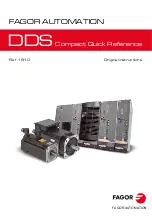
When using additional proximity
sensors:
• Place the proximity sensors in the
corresponding grooves. Cover rails
over the grooves fasten the cables
and protect them against dirt.
• During assembly, maintain the
required minimum distances from
ferrous materials.
Fig. 6
7.2 Electrical installation
Warning
• Use only power sources which guarantee reliable electrical isolation of the
operating voltage in accordance with IEC/DIN EN 60204-1.
Observe also the general requirements for PELV power circuits in accordance
with IEC/DIN EN 60204-1.
Note
Installation errors can damage the electronics or cause malfunctions.
• Make sure that the length of the displacement encoder cable does
not
exceed
the permissible length of 30 m.
• Connect the earth terminal (Fig. 1
7
) to the earth potential with low imped-
ance (short cable with large cross-section) – tightening torque 5 Nm ± 10 %.
• Observe the pin allocation (
Fig. 8). The displacement encoder may only be
used as a voltage divider –
not
as a variable resistor.
• Use an electric connecting cable, with at least 3 wires, with an outside dia-
meter of 6.5 to 8 mm – wire cross section [mm²] 0.75 … 1.5.
• Recommendation: Use the pre-assembled connecting cable NHSB with protect-
ive conduit according to accessories (
www.festo.com/catalogue).
The electrical connection is covered by the flange receptacle (
Fig. 1).
To perform electrical installation you will have to dismantle the flange receptacle.
The structure of the flange receptacle and the cable conduit fitting are shown in
the following illustration:
1
Mounting screws –
tightening torque
Fig. 9
2
Seals (O-rings)
3
Mounting thread (M32 x 1.5) for
connecting cable (accessories) –
tightening torque
15 Nm ± 10 %.
Fig. 7
1
2
3
1. Loosen the mounting screws of the flange receptacle (
Fig. 7
1
) and carefully
remove the flange receptacle.
2. If necessary, loosen the cable conduit fitting of the connecting cable (available
optionally in combination with the connecting cable) in accordance with the
related assembly instructions.
3. Plug the electrical connecting cable through the passage of the flange recept-
acle (
Fig. 10
1
).
4. If necessary, loosen the socket strip of the electrical connection, which is
fastened with two screws.
5. Use the wire end sleeves appropriate for the connection and wire the socket
strip according to the pin allocation (
Fig. 8) – tightening torque
0.22 Nm … 0.25 Nm.
The 3-pin connection is used to supply voltage to the integrated displacement
encoder and to make the sensor signal available.
Pin
Assignment
1)
Connection
1
Operating voltage -
3
1
2
Output actual value (0 … 15 V DC)
3
Operating v
1)
Maximum permissible operating voltage 15 V DC
Fig. 8
6. Carefully plug the wired socket strip onto the plug.
7. Refasten the socket strip with the two screws – tightening torque:
0.5 Nm ± 10 %.
8. Remount the flange receptacle. When doing so, make sure that the seals and
O-rings are correctly seated.
9. When tightening the mounting screws of the flange receptacle, observe the
tightening torque (
Fig. 9).
Tightening torque of the mounting screws of the flange receptacle
Design
DFPI-100-...-E-P-G2 up to
DFPI-160-...-E-P-G2
DFPI-200-...-E-P-G2 up to
DFPI-320-...-E-P-G2
Tightening torque
[Nm]
2.7 ± 10 %
6 ± 10 %
Fig. 9
7.3 Pneumatic installation
• Use the pre-assembled connecting cable NHSB with protective conduit accord-
ing to accessories (
www.festo.com/catalogue) or externally calibrated pneu-
matic connection lines with outside diameter of 8 mm. Suitable, for example, is
the plastic conduit PUN-8x1,25 from Festo.
• Check the necessity of check valves. You will then prevent the moveable mass
sliding down if there is a drop in pressure when the product is in a vertical or
sloping mounting position.
The flange receptacle has two threaded holes (
Fig. 10). Push-in fittings are
pre-assembled in the factory (included in scope of delivery).
Connect the tubing of the DFPI as follows:
1. If necessary, loosen the cable conduit fitting of the optional connecting cable
(
assembly instructions of the accessories).
2. Remove the blanking plugs at the push-in fittings, if necessary.
1
Passage for electric cables
2
Pneumatic connection 2:
retract piston rod
3
Flange receptacle
4
Pneumatic connection 4:
advance piston rod
Fig. 10
1
2
3
4
3. Connect the tubing of the DFPI to the compressed air supply ports (
Fig. 10).
To do this, plug the respective tube into the corresponding push-in fitting up to
the stop.
– Air supply at port 2 (
Fig. 10
2
): Piston rod retracts
(open process valve)
– Air supply at port 4 (
Fig. 10
4
): Piston rod advances (close process valve)
4. Only in the unpressurized status: Check the reliable hold of the tubing connection
by lightly pulling on the tubing.
5. With use of the connecting cable available as an accessory: Mount the cable
connector, if necessary, and protective conduit in accordance with the related
assembly instructions.
Loosening a tube
1. Press down on the disconnect ring (blue) of the push-in fitting and hold it down.
2. Carefully pull the tube out of the push-in fitting.
Cut off the damaged part before further use of the tube.






















